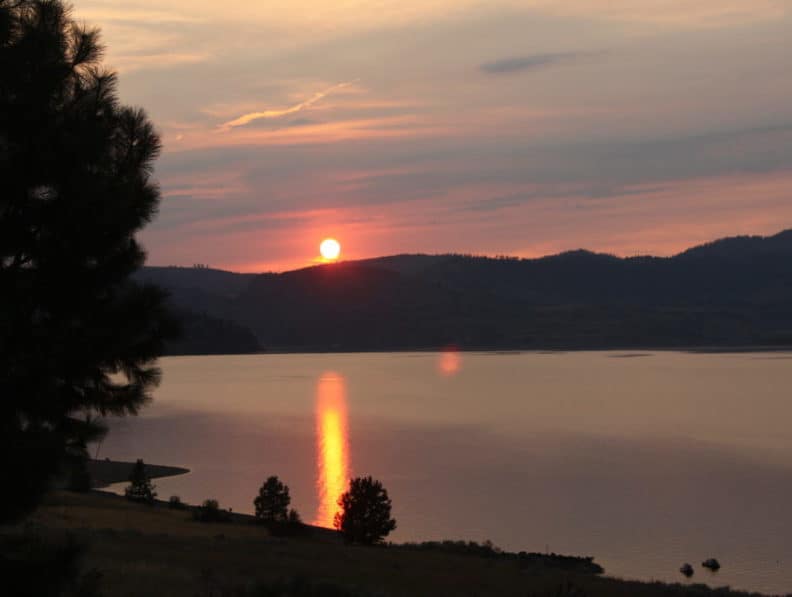
Pondering Pine: A Life Story of a Ponderosa Pine Tree
By Ash Kunz, graduate student in the Institute’s 16th cohort.
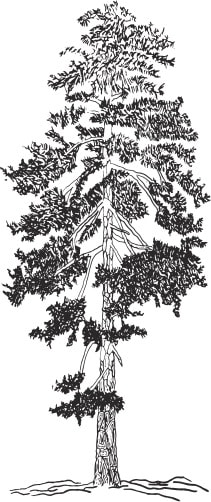
Ponderosa Pine. Illustration by Ash Kunz
The story of my life is the story of the land in which I am rooted. There have been more changes than are imaginable. It is a landscape that has been shaped by both natural forces and human hands. It is a ruggedly beautiful place – from the shrub steppe and dry forest ecosystem that descends 1000 meters to the once roiling river, now tamed and known as the Columbia. In times of warmth, my views are consumed with the iconic yellow and purple of balsamroot and lupine. In times of cold, the Earth is blanketed with a thick layer of pristine white snow. I have grown tall and broad and strong – fed by the soil and the water and the sun. I have seen humankind change. I have tasted fire and flood. I have heard the stories of glaciers and volcanoes; I have felt the Earth quake. I have heard axes and saws and machines. I have seen the young grow old. I have felt the change of time. My relationship with people, animals and plants is cyclic. Many beings have come and gone; they breed, live and pass.
My brothers and sisters and I have known many names: Black Pine, Western Yellow Pine, Bull Pine, Long-leafed Pine, Blackjack, Yellow-belly, Red Pine, and Silver Pine. The name that I hold dearest in my heart of hearts is Ponderosa Pine – meaning heavy, massive and significant. And I am significant. Over millennia, fire shaped our adaptations and wrote itself into our genetic code. My Pinus cousins are spread throughout the whole of what is known as the Northern hemisphere. Originating on the super-continent of Laurasia, we evolved alongside flowering plants, but they grew faster and stronger, so we adapted. We thrive in regions disturbed by fire. Our family further differentiates into our human-categorized species. I am Pinus ponderosa; fire clears my competition and I endure. My thick bark, with its large, overlapping puzzle-piece plates protects me from all but the most intense fires.
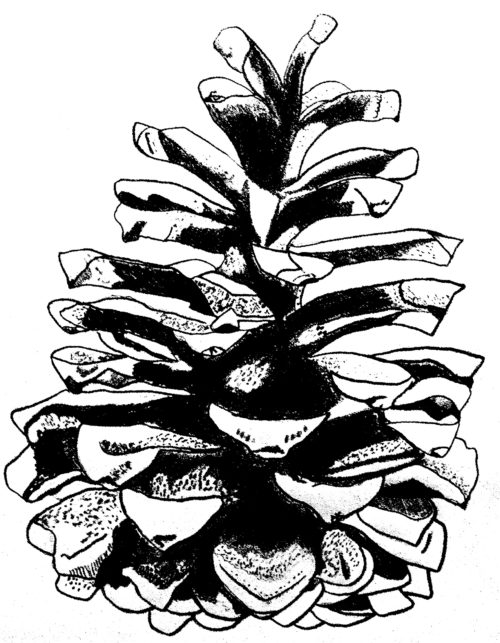
Ponderosa pine cone. Illustration by Ash Kunz
My native range spans from the Fraser River drainage at latitude 52° N to the mountainous slopes of the southern Sierra Nevada’s at latitude 33° N, from the montane west coast to the eastern edge of the Continental Divide at longitude 110° W, from sea level to 3,281 m in elevation. I subsist in soils derived from igneous, metamorphic and sedimentary parent materials. In coarse, well draining soils, often found in drier climates, my brother and sisters are prolific. Douglas fir and Grand fir are usually my closest neighbors, but western Larch, Quaking aspen and Paper birch, along with a few others often associate themselves in the same environments and zones. High above the ground and the heads of the other inhabitants, my needles soak up the sun. They are bundled into fascicles of three, each needle in the group between five and ten inches long – a merry tuft at the tips of my boughs. Amongst my needles, nestled along the outer reaches of my branches hang my heavy cones. Heavy for their 3-5 inch size, each scale has a stiff prickle of fortification. Fanning out from the peduncle at the base, the scales coil along the rachis and create a hypnotically striking, variegated arc, their color complementing the rich character of my armored trunk. My bark is a robust and warm shade of cinnamon, deeply furrowed. My perfume a rich vanilla, and on warm days my heady aroma fills the forest. My very existence is a statement of the landscape.
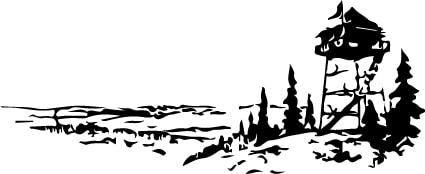
Fire lookout. Illustration by Ash Kunz
Flame is my most obvious statement. I have always known fire; from the fire that cultivated the ground in preparation for my founding to the hot, sweltering blazes that licked my limbs and singed my bark. It was the severe fires when I learned what it is bear the pain of flame. I will never forget the white bite and blinding agony. My vessels contracted, pulling away from the heat. As my outer bark burned, fragments flaked off, taking the heat and flame with it. That reduced heat transfer and minimized injury to my sensitive inner cambium. Because I self-pruned, the fire could not travel up my limbs and irreparably ravage my crown.
Disturbances shaped Mother Earth and left their story inscribed on her face. Be these disturbances natural or human driven, their mark has forever transformed our environment – for better or for worse. I exist with certain interdependence to all beings dwelling on Mother Earth, but through the duration of my lifetime, which is lengthy compared to human lifespans, and puny compared to the span of time the Mother has breathed, that relationship has been distorted in so many ways. I no longer witness human children grow, playing amongst my brothers and sisters. Few people walk between my neighbors and I, taking in our beauty or our stories. The fires that burn erupt with intensity, obliterating all in their path. My needles are choked with pollution. The Earth is fighting for survival.
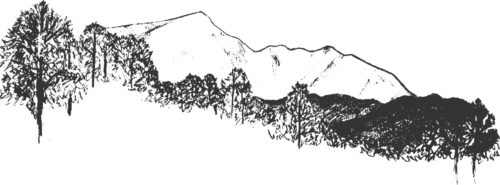
Mountain landscape. Illustration by Ash Kunz
If those inhabiting the Earth ignore the past, the future of our Mother and all her descendants are doomed to continue on this path of ruin. We are all interconnected . No one species can truly thrive if that means sacrificing another. There is always hope though. I have seen my brothers and sisters take root in the most inhospitable terrain. In what seems like solid rock, runs a small crack that has filled with soil and captures the sparse downpour of water. It is in this crack that they send their taproot. In time, they grow and that stone splits – no match for the power and tenacity of life. If a single tree can fragment a pillar, the resilience of all beings on Earth unifying with a collective purpose would be unrelenting.


I Have always loved the Pondwrosa pine of Mormon lake Ariz. . whether it be sweet smell in the very early morning or the sound of the wind going through them in the afternoon. So majestic.
What a delightful ode to this majestic tree. Thank you